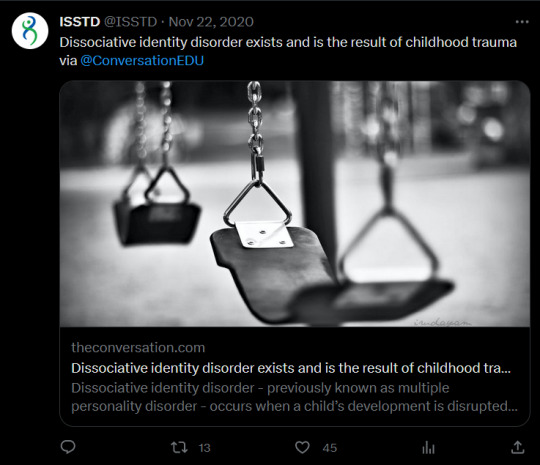#I've tried to include a bunch of different types of resources from professionals
Explore tagged Tumblr posts
Text
It's debunk time!

Hmmmmmmmm
Let's see
Dissociative Identity Disorder (2018)
Dissociative identity disorder is increasingly understood as a complex and chronic posttraumatic psychopathology closely related to severe, particularly early, child abuse.
Speaking of Psychology: What is dissociative identity disorder? With Bethany Brand, PhD (2022)
It doesn't mean that then trauma is not traumatic, because of course it still is, but over time, if that happens again and again and again, the child—because DID is a developmentally based trauma disorder, it starts in very early childhood.
Dissociative Identity Disorder: Etiology, Media, and Stigma (2020) PDF
With all the evidence, one can conclude that the posttraumatic model of Dissociative Identity Disorder is the one that accurately describes the etiology of this complex disorder.
Disorganized Attachment and the Orbitofrontal Cortex as the Basis for the Development of Dissociative Identity Disorder
One particularly promising theory posits that, in addition to traumagenic origins, infant disorganized attachment may be a significant contributor to the development of DID. Neuroimaging studies have identified areas of the brain, the orbitofrontal cortex in particular, that function differently in DID patients, thus providing a neurobiological basis for the disorder. By examining the effects of trauma on neurodevelopment, some of the differences between the normal and the DID brain can be accounted for. Attachment theory allows the cause of DID to be traced even further back to neurodevelopment that occurs during infancy. The combination of disorganized attachment with later childhood trauma provides a strong basis for the development of DID.
Dissociative Disorders in the DSM 5 (2011)

Dispelling Myths About Dissociative Identity Disorder Treatment: An Empirically Based Approach (2014) PDF
The entire goddamn paper--- just read it
Revisiting the etiological aspects of dissociative identity disorder: a biopsychosocial perspective (2014) PDF
Dissociative identity disorder (DID) is a chronic post-traumatic disorder where developmentally stressful events in childhood, including abuse, emotional neglect, disturbed attachment, and boundary violations are central and typical etiological factors.
Trauma-Related Dissociation and the Dissociative Disorders (2022)
Again, just the entire paper
Childhood trauma in patients with Dissociative Identity Disorder: A systematic review of data from 1990 to 2022 (2023)
Overall, those with DID and dissociative disorders reported more emotional and physical neglect, emotional abuse, physical abuse, and sexual abuse than those with PTSD, schizophrenic disorders, panic disorders, and complex partial epilepsy or control. Only two studies stressed early reported age as a factor in trauma exposition among the DID population. Reinders et al. (2018) established reported childhood traumas between 0 and 6 years, whereas Scroppo et al. (1998) estimated averages of 3 years for physical abuse and sexual abuse.
The ISSTD (obviously)

Sleep, trauma, fantasy and cognition in dissociative identity disorder, post-traumatic stress disorder and healthy controls: a replication and extension study (2020)
The current study shows that traumatization is the most important predictor of dissociation in individuals with DID and we assume that sleep disturbances are likely to be related to nightmares due to traumatic childhood experiences.
A Model of Post-Traumatic Stress Disorders and Dissociative Identity Disorder from the perspective of Social Emotions (2022)
Post-Traumatic Stress Disorder, Complex Post-Traumatic Stress Disorder and Dissociative Identity Disorder are conditions caused by exposure to one or more stressful events of extraordinary magnitude and/or repeated over many years. The traumatic experience(s) may have different outcomes in different persons: some people fully recover within a short time, while others go on to develop one of these three disorders, whose interdependencies are still poorly understood.
#syscourse#debunk#trauma model#resources#dissociative identity disorder#should I keep going? because I can#I've tried to include a bunch of different types of resources from professionals
111 notes
·
View notes